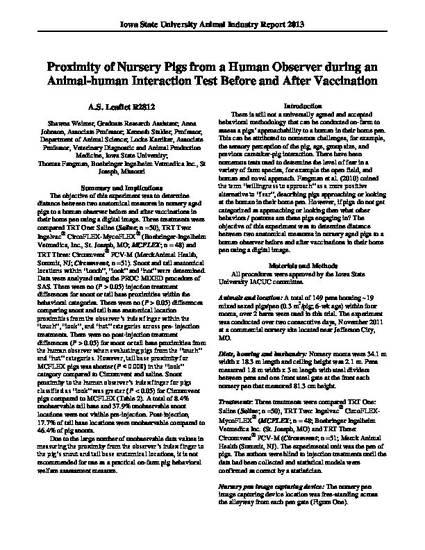
The objective of this experiment was to determine distance between two anatomical measures in nursery aged pigs to a human observer before and after vaccinations in their home pen using a digital image. Three treatments were compared TRT One: Saline (Saline; n =50), TRT Two: Ingelvac® CircoFLEX-MycoFLEX® (Boehringer-Ingelheim Vetmedica, Inc., St. Joseph, MO; MCFLEX; n = 48) and TRT Three: Circumvent® PCV-M (MerckAnimal Health, Summit, NJ; Circumvent; n=51). Snout and tail anatomical locations within “touch”, “look” and “not” were determined. Data were analyzed using the PROC MIXED procedure of SAS. There were no (P > 0.05) injection treatment differences for snout or tail base proximities within the behavioral categories. There were no (P > 0.05) differences comparing snout and tail base anatomical location proximities from the observer’s index finger within the “touch”, “look”, and “not” categories across pre- injection treatments. There were no post-injection treatment differences (P > 0.05) for snout or tail base proximities from the human observer when evaluating pigs from the “touch” and “not” categories. However, tail base proximity for MCFLEX pigs was shorter (P < 0.008) in the “look” category compared to Circumvent and saline. Snout proximity to the human observer’s index finger for pigs classified as “look” was greater (P < 0.05) for Circumvent pigs compared to MCFLEX (Table 2). A total of 8.4% unobservable tail base and 37.9% unobservable snout locations were not visible pre-injection. Post-injection, 17.7% of tail base locations were unobservable compared to 46.4% of pig snouts.
Due to the large number of unobservable data values in measuring the proximity from the observer’s index finger to the pig’s snout and tail base anatomical locations, it is not recommended for use as a practical on-farm pig behavioral welfare assessment measure.
Available at: http://works.bepress.com/kenneth_stalder/50/
